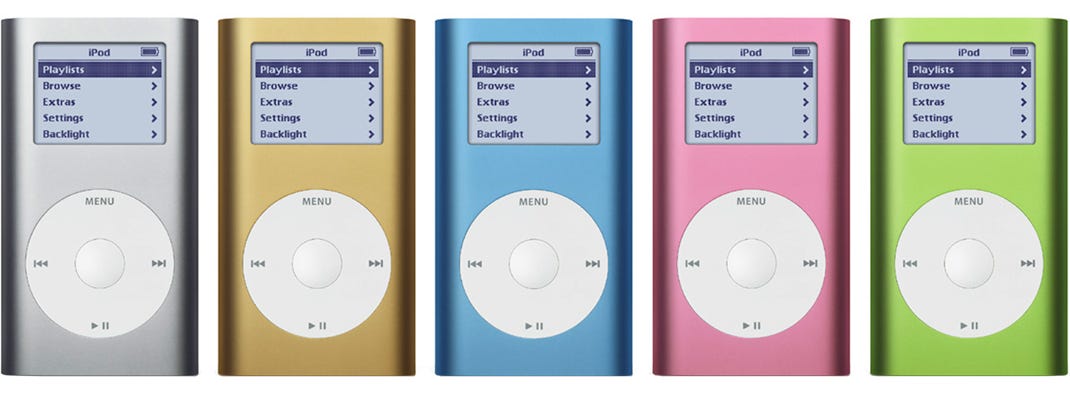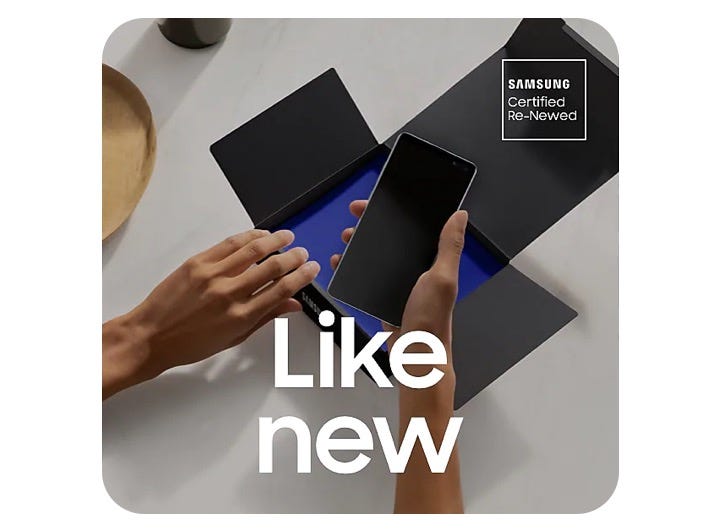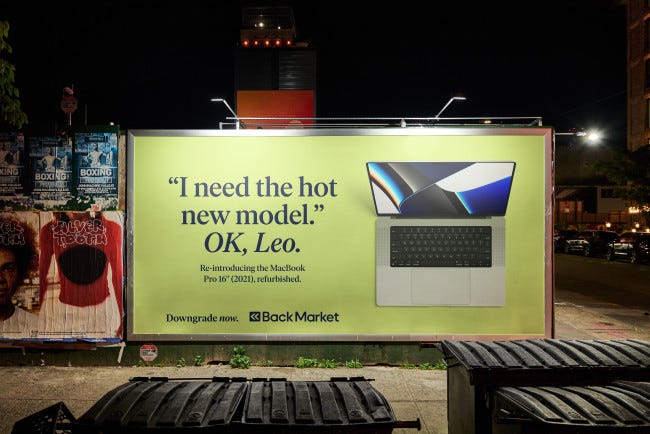Hold On To Your iPods: Refurbished Electronics Could Be the Next Zero-Billion-Dollar Market
Is old tech coming back in a big way? Inside the unexpected boom reshaping tech commerce, from corporate powerhouses to scrappy newcomers, and why your next device might just come with a past.
Issue #9
As I mentioned in last' week’s newsletter, you might want to hold on to your old iPod mini because this week’s deep dive looks at the rapidly growing market for refurbished electronics and asking if it might fit Jensen Huang’s concept of a “zero-billion-dollar” phenomenon. Could it transform from a quiet niche into a multi-billion-dollar force?
Why Refurbished Tech Is Buzzing
Refurbished devices, including phones, laptops, and gaming consoles, are gaining ground for three major reasons:
Market Potential
The refurbished smartphone sector alone is forecasted to reach about $140 billion in global revenue by 2027. This number reflects a surge in interest, fueled by both trade-in programs and consumer demand.Changing Consumer Sentiment
There is a growing awareness around e-waste and sustainability. Warranties and certifications are helping refurbished products shed the old stigma of being a risky choice.Cost Benefits
Buyers often enjoy discounts of 30% - 50% off new-device prices. This matters in a tech landscape where flagships can cost well beyond $1,000.
These factors are creating an ecosystem that could, in time, mirror other “zero to billions” expansions we have seen in the tech world, like streaming services (Netflix and Hulu), ridesharing (Uber and Lyft), and cloud computing (AWS and Azure).
Verizon: Building on Trust
Verizon is leveraging its brand strength to shift perceptions about used devices. While wireless services and new phone promotions are still its bread and butter, there’s a clear strategy for refurbishing:
Offline Advantage
With an extensive network of stores, Verizon can display refurbished devices side by side with new ones. This face-to-face experience helps skeptical buyers see and handle products in person.Trade-In Pipeline
Verizon’s trade-in system feeds a steady stream of used phones, which are then refurbished and sold with warranties. That continuous loop is an easy way to keep customers engaged.Market Share Consideration
Verizon has more than 140 million wireless subscribers in the United States, so it already has a giant audience ready to be upsold or introduced to refurbished deals. Although the refurb category isn’t the company’s primary focus, it’s becoming a worthwhile revenue channel.
Verizon doesn’t need to shout about refurbishment. It only needs to keep the option visible and reliable enough that buyers trust they can save money without sacrificing peace of mind.
Samsung: Quality Meets Longevity
Samsung’s rapid product cycles provide a steady flow of lightly used devices. The company uses two main strategies:
Premium Branding
Marketing materials show refurbished phones with a sleek finish and near-original packaging. Samsung often presents these alongside its newest models to drive home the point that last year’s Galaxy still stands tall.
Online and Offline Integration
Samsung sells its certified refurbished devices through official online channels, but it also features them in physical retail outlets. This dual approach, similar to Verizon’s, lets customers try before buying.
Thanks to Samsung’s standing as a major smartphone maker, they capture a large chunk of refurb supply, second only to Apple in many regions. This positions them well for continued growth in secondhand sales.
Back Market: Bold Voices and a “Downgrade” Campaign
Back Market is one of my favorite startups on my watch list! I love how strong their branding is - it really stands out in a sea of homogenous gen-z targeted brands. Back Market is a dedicated online marketplace for refurbished gadgets and while originally founded in France, it is quickly gaining traction in the US and across Europe.
Who They Are
Back Market serves as a one-stop shop, aggregating refurbished devices from vetted sellers. They aim to match or exceed the reliability of new device purchases, offering warranties and user-friendly return policies.Cheeky Marketing and the “Downgrade” Concept
Their recent “Downgrade Now” campaign flips the usual hype around upgrading. They suggest that older models, like classic iPhones, can still be a smart choice for consumers. This angle resonates with those feeling tired of never-ending new product releases.In-House Creative and Multichannel Ads
By keeping their creative work internal, Back Market ensures a consistent tone across billboards, bus stops, and social media. Imagine a city bus stop poster that says, “Upgrade? Nah. Downgrade and Save Your Wallet,” paired with a bright, illustrated phone.
This approach helps them stand apart, attracting younger or eco-conscious shoppers who appreciate humor and transparency.Growth Trajectory
Although exact sales figures are private, Back Market’s expansion into multiple countries suggests rising market share. Because their entire business is built on refurbished products, every campaign dollar goes into boosting that specific message.
TipTop: Transparency and the Path to Growth
TipTop is a smaller name, but it has a shot at success if it highlights its step-by-step refurbishing process and customer-oriented focus.
Company Background and Core Values
TipTop advertises itself as a premium refurb service, complete with quality ratings for each device and rigorous testing. The company is relatively young but aims to build its identity on thoroughness and reliability.Strategy Expansion
TipTop could use behind-the-scenes videos or collaborations with known influencers to show how devices are restored. A limited brick-and-mortar presence, or pop-up events, might also help them connect with cautious buyers.Niche Edge
As an upstart that prioritizes refurb above everything else, TipTop can potentially outpace bigger players that see refurbished tech as a smaller vertical. If they excel at quality checks and customer satisfaction, word-of-mouth could become a powerful growth engine.
Offline vs. Online: Advantages and Trade-Offs
Verizon and Samsung
Both companies benefit from store networks, giving them a chance to showcase refurbished items firsthand. They also have the advantage of large marketing budgets and established customer bases. However, refurb remains a single part of their overall strategy, which may limit focus.Back Market and TipTop
Being online-first lets these newcomers stay agile, use bold creative messages, and invest heavily in direct engagement. However, a lack of offline presence might hinder conversions for those who prefer a more tangible shopping experience. The trade-off is a laser focus on making refurb a premium alternative to new tech.
From Zero-Billion to Blockbuster?
Jensen Huang’s idea of industries going from “zero” to “billions” might not be so far-fetched when looking at the growth of refurbished electronics. Factors like environmental awareness, high smartphone prices, and the promise of warranties are pulling more consumers into secondhand buying than ever before.
Scale Drivers
Corporate push and acceptance at retail locations
Eye-catching campaigns from dedicated refurb brands
Increased consumer familiarity and reduced stigma
Put simply, the stage is set for rapid expansion if these trends continue. We could see refurbished electronics turn from a side option into a powerhouse sector, rivaling or surpassing other tech-related booms in recent memory.
Turning Skeptics Into Believers
A few years ago, “refurbished” might have sounded risky or second-best. Today, the narrative is changing:
Sustainability Motivations
Many consumers are eager to reduce e-waste and carbon footprints. A phone that’s already in circulation offers a greener choice than an all-new one that requires fresh resources.Improved Quality Control
Brands now offer thorough checklists and multiple refurbishment grades. This gives shoppers tangible proof that their device has been tested and approved.Competitive Pricing
Price gaps are widening between new flagship devices and refurbished models, so the value proposition grows stronger each year.
The Takeaway
Refurbished electronics are moving from niche to mainstream, and the conditions mirror other industries that started from near invisibility and shot up to billion-dollar heights, exactly as Jensen Huang has described. Verizon and Samsung bring established reach and retail clout, while Back Market and TipTop focus on creative messaging, specialized branding, and direct consumer engagement.
Which model wins out is anyone’s guess, but one thing seems certain: the “old phone in a drawer” might soon find a new life in someone else’s pocket, and that cycle could be worth billions. As a 90s kid, I live for the nostalgia and would happily pay for a colorful iPod mini with the teeny LCD display so I have a device dedicated just for music. Yes, I do miss single-utility electronics and feel the need to be unreachable every so often.
What are your thoughts on the secondhand tech market - is it here to stay and would you buy a pre-loved phone or camera?







Yes! Love this. The vintage camera market is booming, and brands are now pushing out 6K production for camcorders. It reflects our collective desire to return to simpler times—whether that means childhood nostalgia or a world less connected, overstimulated, and overwhelming.
I always think about how when something grows infinitely, it becomes a cancer—and that’s never a good thing. Our current state with tech and AI is overdevelopment and that comes at a cost.